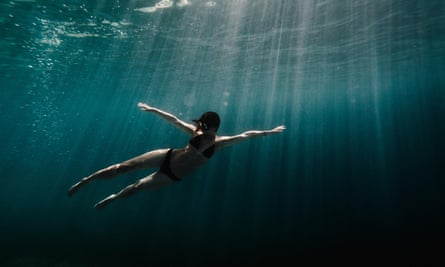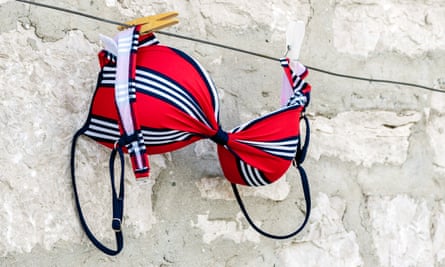
Last year, I moved from Melbourne to Sydney and swapped the much-loved Fitzroy Pool for saltier laps at Icebergs in Bondi. The water was freezing in the middle of winter, so I bought a swimming cap and broke up each swim with spells in the sauna.
As the year rolled forward and the weather warmed up, I got to know the rest of Sydney’s pools. Clovelly for immersion, Bronte for quick laps, Mahon to escape the crowds. Most swimmers I know are addicted to the rhythm and the silence. To the feeling of escape and transformation that comes from being submerged in the ocean.
But most swimwear is made using synthetic materials like polyester and nylon. These are derived from fossil fuels – meaning they won’t biodegrade. It is unfortunate that swimwear can cause damage to the very environment it allows you to enjoy, but thoughtful shopping and better washing can limit a bathing suit’s impact.
Materials matter
There are not many alternatives to synthetic swimwear. Dale McCarthy of swimwear brand Bondi Born says this is “not ideal for the planet,” but “by its nature, [swimwear] requires the garment to stretch and not hold water” so natural fibres can’t be used because they are too absorbent, and become misshapen when wet.
While there are some plant-based materials such as bamboo entering the swimwear market – and experimental options such as Kelly Slater’s woollen boardshorts – they still need to be blended with synthetic fibres to ensure they have enough stretch to make a functional one-piece or a bikini.
To reduce the impact of synthetics, some brands turn to recycled materials. Two of the most common recycled swimwear fabrics are Repreve, which is a polyester made from plastic bottles, and Econyl, a nylon made from fishing nets and carpets.
Most recycled synthetics need to be blended with virgin materials to ensure the quality of the garment isn’t compromised. Look for fabrics that have certifications such as the Recycled Claim Standard (RCS) and the Global Recycled Standard (GRS) to ensure they have been responsibly produced.
Seek out quality
Liandra Gaykamangu, the founder and creative director of Liandra Swim, says it’s worth doing some research and getting to know a brand and “what their ethos is around sustainability, as a whole” before you commit to a new swimsuit. “It should be about more than just the product.”
Look for brands using eco-friendly fabric dyes and compostable or recyclable packaging. Pay attention to the location where the fabric was milled and the type of energy being used at the factory. To ensure any statements on a brand’s website are more than just good intentions, keep an eye out for fabrics that have third party sustainability certifications. Oeko-tex, for example, certifies that no harmful chemicals have been used in the fabric’s manufacturing processes.
High quality fabrics “not only perform better on the body,” says McCarthy, “but they last … longer than average swim fabrics, release far fewer microplastics into our water systems and reduce the need to constantly buy swimwear due to degradation of the stretch fibres through exposure to salt, sun, chlorine, sun cream and washing”.
Implausible as it sounds, some bathing suits cannot withstand laps in a swimming pool, so it is always worth checking the garment care instructions before you make a purchase. If a swimsuit advises you to avoid exposure to chlorine, avoid buying that swimsuit.
And be wary of anything marketed as quick drying, as this is often achieved by applying PFAs, chemicals that have been connected to a range of health concerns.
Buy less, wear more
Whether it is made of recycled or virgin material, as with all clothing, the most sustainable swimwear option will be a costume that will last (and that you will love) for a long time.
Colour, shape and fit are all important, McCarthy says. “Black, navy or cream, and shapes like plunge v’s and square necks will never go out of style.” As for fit: “If the swimsuit doesn’t fit you well and doesn’t make you feel confident when you wear it, you probably won’t.”

Care for your swimwear
The way we care for our swimwear also changes its environmental impacts.
Gaykamangu recommends using a Guppy Friend washing bag when putting your swimsuit through a wash cycle. “This can help to capture any nasty microplastics that come off the fabric … We don’t want micro-plastics ending up in our waterways and in the stomachs of small animals and therefore into our food chain,” she says.

Ensuring chlorine and salt is thoroughly rinsed off your swimsuit after each wear will also help extend its lifespan.
Since heat can damage synthetic fabrics, be sure to only use cold water, never put your swimsuit in the dryer and leave it in the shade to dry. See this previous Closet Clinic for more advice on caring for your swimwear.
Finally, if you are wondering what to do with your old swimsuits, since donating and recycling them can be tricky, Gaykamangu has a creative suggestion for repurposing swimwear that is no longer functional: make an accessory of it. “Think scrunchies and hair ties,” she says.



